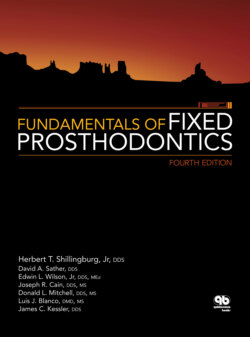Читать книгу Fundamentals of Fixed Prosthodontics - James C. Kessler - Страница 116
На сайте Литреса книга снята с продажи.
Biomechanical Considerations
ОглавлениеIn addition to the increased load placed on the periodontal ligament by a long-span fixed partial denture, longer spans are less rigid. Bending or deflection varies directly with the cube of the length and inversely with the cube of the occlusogingival thickness of the pontic. Compared with a fixed partial denture having a single-tooth pontic span (Fig 7-13), a two-tooth pontic span will bend 8 times as much (Fig 7-14). A three-tooth pontic will bend 27 times as much as a single pontic13 (Fig 7-15).
A pontic with a given occlusogingival dimension (Fig 7-16) will bend eight times as much if the pontic thickness is halved (Fig 7-17). Therefore, a long-span fixed partial denture on short mandibular teeth could have disappointing results. Longer pontic spans also have the potential for producing more torquing forces on the fixed partial denture, especially on the weaker abutment. To minimize flexing caused by long and/or thin spans, pontic designs with a greater occlusogingival dimension should be selected. The prosthesis may also be fabricated of an alloy with a higher yield strength, such as nickel-chromium.
Fig 7-18 The walls of facial and lingual grooves counteract mesiodistal torque resulting from force applied to the pontic.
Fig 7-19 The retainers on secondary abutments will be placed in tension when the pontics flex, with the primary abutments acting as fulcrums.
Fig 7-20 Secondary retention (R) must extend a distance from the primary interabutment axis equal to the distance that the pontic lever arm (P) extends in the opposite direction.
All fixed partial dentures, long or short, flex to some extent. Because of the forces being applied through the pontics to the abutment teeth, the forces on castings serving as retainers for fixed partial dentures are different in magnitude and direction from those applied to single restorations. 14 The dislodging forces on a fixed partial denture retainer tend to act in a mesiodistal direction, as opposed to the more common faciolingual direction of forces on a single restoration. Preparations should be modified accordingly to produce greater resistance and structural durability. Multiple grooves, including some on the facial and lingual surfaces, are commonly employed for this purpose (Fig 7-18).
Double abutments are sometimes used as a means of overcoming problems created by unfavorable crown-root ratios and long spans. There are several criteria that must be met if a secondary (remote from the edentulous space) abutment is to strengthen the fixed partial denture and not become a problem itself. A secondary abutment must have at least as much root surface area and as favorable a crownroot ratio as the primary (adjacent to the edentulous space) abutment it is intended to bolster. As an example, a canine can be used as a secondary abutment to a first premolar primary abutment, but it would be unwise to use a lateral incisor as a secondary abutment to a canine primary abutment. The retainers on secondary abutments must be at least as retentive as the retainers on the primary abutments. When the pontic flexes, tensile forces will be applied to the retainers on the secondary abutments (Fig 7-19). There also must be sufficient crown length and space between adjacent abutments to prevent impingement on the gingiva under the connector.
Arch curvature has its effect on the stresses occurring in a fixed partial denture. When pontics lie outside the interabutment axis line, the pontics act as a lever arm, which can produce a torquing movement. This is a common problem in replacing all four maxillary incisors with a fixed partial denture, and it is most pronounced in the arch that is pointed in the anterior. Some measure must be taken to offset the torque. This can best be accomplished by gaining additional retention in the opposite direction from the lever arm and at a distance from the interabutment axis equal to the length of the lever arm15 (Fig 7-20). The first premolars sometimes are used as secondary abutments for a maxillary four-pontic canine-to-canine fixed partial denture. Because of the tensile forces that will be applied to the premolar retainers, they must have excellent retention.
Fig 7-21 In this frequently occurring situation, the maxillary first premolar and molar are missing, leaving the second premolar as a pier abutment.
Fig 7-22 The amount of faciolingual movement (in μm) for each tooth in the maxillary arch (based on data by Rudd et al16). The direction of movement, indicated by arrows, varies considerably from the anterior to the posterior segment of the arch.
